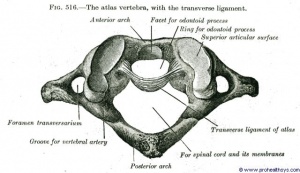Transverse Ligament Stress Test: Difference between revisions
No edit summary |
Evan Thomas (talk | contribs) mNo edit summary |
||
| Line 2: | Line 2: | ||
'''Original Editor '''- [[User:Tamara Eller|Tamara Eller]] and [[User:Audrey Pittman|Audrey Pittman]] | '''Original Editor '''- [[User:Tamara Eller|Tamara Eller]] and [[User:Audrey Pittman|Audrey Pittman]] | ||
'''Top Contributors''' - {{Special:Contributors/{{FULLPAGENAME}}}} | '''Top Contributors''' - {{Special:Contributors/{{FULLPAGENAME}}}} | ||
</div> | </div> | ||
== Purpose | == Purpose == | ||
Test for hypermobility of the atlantoaxial articulation | Test for hypermobility of the atlantoaxial articulation | ||
== Technique <ref>↑ Dutton, M. (2008). Orthopaedic: Examination, evaluation, and intervention (2nd ed.). New York: The McGraw-Hill Companies, Inc.</ref> == | == Technique <ref>↑ Dutton, M. (2008). Orthopaedic: Examination, evaluation, and intervention (2nd ed.). New York: The McGraw-Hill Companies, Inc.</ref> == | ||
| Line 16: | Line 16: | ||
*The Therapist then lifts the patients head and C1 vetebra anteriorly, without allowing flexion or extension. | *The Therapist then lifts the patients head and C1 vetebra anteriorly, without allowing flexion or extension. | ||
*The position should be held for 10-20 seconds. | *The position should be held for 10-20 seconds. | ||
*A positive test is the | *A positive test is the recurrence of symptoms: | ||
##Abnormal pupil response | |||
#Abnormal pupil response | ##Eye twitching or nystagmus | ||
#Eye twitching or nystagmus | ##Soft end feel | ||
#Soft end feel | ##Muscle spasm | ||
#Muscle spasm | ##Dizziness | ||
#Dizziness | ##Nausea | ||
#Nausea | ##Paresthesia of the lip face or limb | ||
#Paresthesia of the lip face or limb | ##Lump sensation in the throat | ||
#Lump sensation in the throat | |||
{| width="100%" cellspacing="1" cellpadding="1" border="0" align="center" class="FCK__ShowTableBorders" | {| width="100%" cellspacing="1" cellpadding="1" border="0" align="center" class="FCK__ShowTableBorders" | ||
| Line 43: | Line 42: | ||
== Recent Related Research (from [http://www.ncbi.nlm.nih.gov/pubmed/ Pubmed]) == | == Recent Related Research (from [http://www.ncbi.nlm.nih.gov/pubmed/ Pubmed]) == | ||
<div class="researchbox"><rss>http://www.ncbi.nlm.nih.gov/entrez/eutils/erss.cgi?rss_guid=1Li5J1cBG7VKyJPvjGAL4MJRDJzi9EACMDhmeYih8VqLThD17g|charset=UTF-8|short|max=10</rss> </div> | <div class="researchbox"><rss>http://www.ncbi.nlm.nih.gov/entrez/eutils/erss.cgi?rss_guid=1Li5J1cBG7VKyJPvjGAL4MJRDJzi9EACMDhmeYih8VqLThD17g|charset=UTF-8|short|max=10</rss> </div> | ||
== References == | == References == | ||
<references /> | |||
[[Category:Assessment]] [[Category:Special_Tests]] [[Category:Cervical_Spine]] [[Category:Ligaments]] [[Category:Cervical_Examination]] [[Category:Musculoskeletal/Orthopaedics]] [[Category:MCG_Student_Project]] | |||
[[Category: | |||
Revision as of 07:48, 26 October 2016
Original Editor - Tamara Eller and Audrey Pittman
Top Contributors - Tamara Eller, Audrey Pittman, Admin, Vidya Acharya, Rachael Lowe, Kim Jackson, Evan Thomas, Tony Lowe, Kai A. Sigel, WikiSysop and Anas Mohamed
Purpose[edit | edit source]
Test for hypermobility of the atlantoaxial articulation
Technique [1][edit | edit source]
- The patient is placed in a supine postion with the Therapist supporting the patient's head with the palms and 3rd-5th fingers.
- The Therapist then places the index fingers between the occiput and spinous process of C2, so the index fingers are over the neural arch of the C1 vetebra.
- The Therapist then lifts the patients head and C1 vetebra anteriorly, without allowing flexion or extension.
- The position should be held for 10-20 seconds.
- A positive test is the recurrence of symptoms:
- Abnormal pupil response
- Eye twitching or nystagmus
- Soft end feel
- Muscle spasm
- Dizziness
- Nausea
- Paresthesia of the lip face or limb
- Lump sensation in the throat
Evidence[edit | edit source]
Provide the evidence for this technique here
Resources[edit | edit source]
Pettman E: Stress tests of the craniovertebral joints. In: Boyling, JD, Palastanga N, eds. Grieve's Modern Manual Therapy: The Vertebral Column, 2nd edn. Edinburgh: Churchill Lingstone, 1994:529-538.
Recent Related Research (from Pubmed)[edit | edit source]
References[edit | edit source]
- ↑ ↑ Dutton, M. (2008). Orthopaedic: Examination, evaluation, and intervention (2nd ed.). New York: The McGraw-Hill Companies, Inc.







